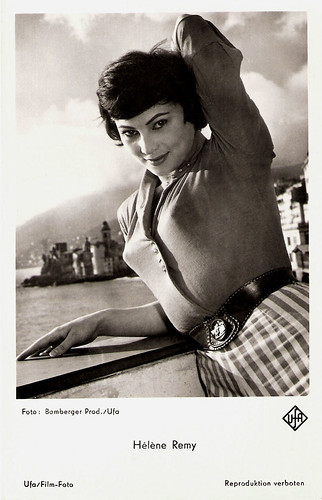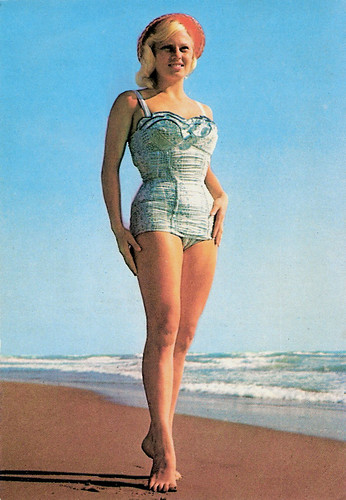
Spanish postcard by Postal Oscarcolor, no. 514.
Miss Cinémonde
Hélène Rémy was born in 1932 in Paris, France, where her father was a butcher. She studied dance and at eight, she danced at the Théâtre du Châtelet. Only 15, Roland Petit committed her to the Ballets des Champs-Elysées to replace a failing dancer.
But her mother changed her direction when she sent a picture of her beautiful, blonde daughter to the magazine Cinémonde for a competition. Hélène perfectly personified the Parisian girl and became second at the Miss Cinémonde contest. The jury included Orson Welles and director Julien Duvivier. Welles offered her a part in his stage production La langouste qui ne pense à rien (The Unthingking Lobster) at the Théâtre Edouard VII in 1950.
Hélène had already made her first uncredited film appearance in Jean Becker's Rendez-vous de juillet/Rendezvous in July (1949) about a group of young jazz-loving Parisians. Small roles followed in Au royaume des cieux/The Sinners (Julien Duvivier, 1949) starring Serge Reggiani, the drama La cage aux filles/The cage girls (Maurice Cloche, 1949), and Les enfants terribles/The Terrible Children (Jean-Pierre Melville, 1950), based on the love story by Jean Cocteau.
She had supporting parts in the lesbian-themed Olivia/The Pit of Loneliness (Jacqueline Audry, 1951) starring Edwige Feuillère, and the Italian comedy Parigi è sempre Parigi/Paris Is Always Paris (Luciano Emmer, 1951) as a fresh and cute French newspaper seller who falls in love with Italian Franco Interlenghi. The film was a huge success in Italy.
Like several other French actresses - Catherine Spaak, Jacqueline Sassard, Lise Bourdin, Isabelle Corey and Myriam Bru - she moved to Rome where she found bigger and more rewarding film roles than in her home country.

German postcard by Ufa, no. FK 4166. Photo: Peter Bamberger Prod. / Ufa. Publicity still for Pezzo, capopezzo e capitano/Always Victorious (Wolfgang Staudte, 1958).

Spanish postcard by Postal Oscarcolor, no. 511.
A popular pin-up and cover girl
In Italy, Hélène Rémy played the female lead in the comedy Un ladro in paradise/A thief in paradise (Domenico Paolella, 1952) and she appeared with Eduardo de Filippo in the comedy-drama 5 poveri in automobile/The Lucky Five (Mario Mattoli, 1952).
Rémy had also become a popular pin-up and cover girl. She appeared opposite the handsome and athletic Pierre Cressoy in the costume drama Il sacco di Roma/The Barbarians (Ferruccio Cerio, 1953). The two also privately became engaged.
Her first leading role was in the romantic comedy Siamo ricchi e poveri/We are rich and poor (Siro Marcellini, 1953) with Gaby André. She often played in Italian costume dramas like Un giglio infranto/A lily broken (Giorgio Walter Chili, 1956) with Milly Vitale.
After a series of mediocre films in which she had leads, she played a supporting part in Dino Risi's great comedy A porte chiuse/Behind Closed Doors (1961) starring Anita Ekberg.
During the 1960s, she only incidentally appeared in films, such as in the Bourvil comedy Les cracks/The Hotshots (Alex Joffé, 1968). She worked often in the Italian theatre and starred in Italian stage versions of Mam'zelle Nitouche and The Lady from Maxim's.
She also appeared for French and Italian TV in such series as Les dossiers de l'agence O/The records of the agency O (1968). Her final film part was as Lydia, the madam of a brothel in the memorable crime drama Borsalino (Jacques Deray, 1970) with Jean-Paul Belmondo and Alain Delon.
Yves Montand sings Les Feuilles Mortes in a scene from Parigi è sempre Parigi/Paris Is Always Paris (Luciano Emmer, 1951) while Hélène Remy dances with Franco Interlenghi. Source: paccaggicco (YouTube).
American trailer for L'amante del vampiro/The Vampire and the Ballerina (Renato Polselli, 1960). Source: Sleaze-O-Rama (YouTube).
Sources: Yvan Foucart (Les Gens du Cinéma - French), Wikipedia (Italian) and IMDb.
Love the pin-up shots. So innocent and modest compared to today
ReplyDelete